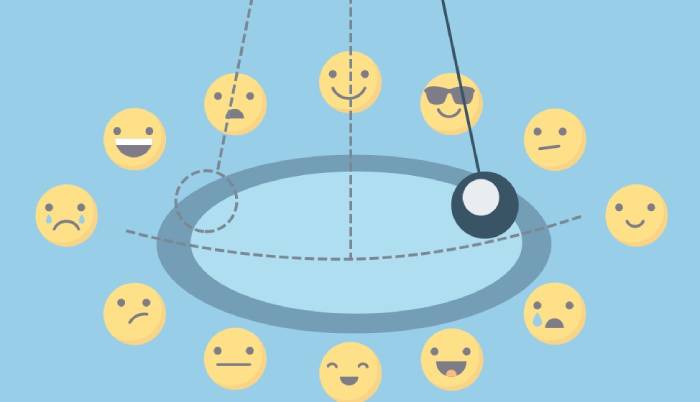Mood swings is a disorder that cannot be taken lightly. Most often you will feel that you’ve made it. The very next moment you’re in trouble. And then you’re back on your feet in no time. It appears that you spend your days on a roller coaster of emotions.

It’s natural to have days when you’re sad and days when you’re ecstatic. Mood swings are generally considered healthy as long as they don’t interfere with your daily life too much.
On the other hand, if you go from being extremely happy to being extremely depressed on a regular basis, you may have a medical condition. You should notify your doctor if you experience severe and frequent mood swings. They can talk about why you’re having them and what might be causing them.
Are these alterations normal? The answer is “maybe,” as long as they don’t interfere with your life or the lives of others.
Many factors can influence your mood throughout the day. Most people, for example, feel upbeat and energetic around noon due to body rhythms but have more negative feelings in the early afternoon or evening.
Mood swings can sometimes be a sign of a mental illness. Alternatively, they could be a sign that something else is going on in your body.
Mental health, hormones, substance use, and other health conditions can all play a role in rapid changes in behaviour.
When should you see your doctor?
It’s not uncommon to have a mood swing or to feel elated or depressed for a short period of time. However, if your behaviour has been inconsistent for several days or longer, it could be a sign of something more serious.
You could be irritable one minute and happy the next. You may also be experiencing emotions that are causing harm to your life.
For instance, you could be so ecstatic that you can’t stop yourself from spending money, confronting people, or engaging in other uncontrollable or risky behaviours
You are unable to visit friends, get enough sleep, go to work, or even get out of bed because you feel like you want to harm yourself or end your life.
Patterns of these kinds of mood swings could indicate a more serious health problem. To talk about your feelings, make an appointment with your doctor. They can help you figure out why you’re feeling this way and what you can do about it.
What factors are linked to mood swings that are severe?
Mood swings are frequently a symptom of a more serious health problem. They can be caused by a variety of factors, including mental health issues, hormonal changes, and substance abuse issues.
Problems with mental health
Mood swings can be caused by a variety of mental health conditions. Mood disorders are a common term for them. The following are some of them:
Bipolar disorder is a mental illness that affects both men and women Your emotions can swing from extreme happiness to extreme sadness if you have bipolar disorder. Even in rapid-cycling bipolar disorder, mood changes associated with bipolar disorder occur only a few times a year.
Cyclothymic disorder is a type of cyclothymia. Cyclothymic disorder, also known as cyclothymia, is a mild form of bipolar II disorder. You have ups and downs in your emotions, but they aren’t as severe as those associated with bipolar disorder.
Bipolar disorder is a mental illness that affects people in (manic-depressive disorder). Bipolar disorder is characterised by mood swings that range from depression to mania. When someone is in a bad mood, the symptoms can be similar to those of clinical depression. Manic episodes or mania alternate with depressive episodes. A person experiencing a manic episode may feel elated, irritable, or have increased levels of activity.
Bipolar disorder is divided into four categories.
Bipolar I is the most severe form of bipolar disorder. Manic episodes can last for up to seven days and may necessitate hospitalisation. Depressive episodes are also common, and they usually last at least two weeks. Symptoms of both mania and depression can appear at the same time in some people.
Bipolar II disorder – Similar to bipolar I, this disorder causes depressive cycles. A person suffering from this illness may also experience hypomania, a milder form of mania. Manic episodes are more intense and disruptive than hypomanic episodes. The majority of people with bipolar II disorder are able to manage their daily lives and do not require hospitalisation.
Cyclothymia disorder (cyclothymia) – Cyclothymia disorder (cyclothymia) is a type of bipolar disorder that is sometimes referred to as a milder version of bipolar disorder.
For long periods of time, people with cyclothymia experience continuous irregular mood swings ranging from mild to moderate emotional “highs” to mild to moderate emotional “lows.” Furthermore, mood swings can happen suddenly and at any time. The normal mood only lasts for a few moments. Symptoms must have been present for at least two years in order for an adult to be diagnosed with the cyclothymic disease. The symptoms must last at least one year in children and adolescents.
“Other” or “unspecified” bipolar disorder – This type of bipolar disorder has symptoms that do not fit into any of the other categories, but people still experience significant abnormal mood swings.
Major depressive disorder (MDD) is a type of depression (MDD). MDD causes you to feel extremely sad for an extended period of time. Clinical depression is another name for MDD.
Dysthymia. Dysthymia, also known as persistent depressive disorder (PDD), is a type of depression that lasts for a long time.
Personality disorders are a type of personality disorder. You may experience rapid mood changes in a short period of time if you have certain personality disorders.
Disruptive mood dysregulation disorder (DMD) is a type of mood dysregulation disorder (DMDD). Children are usually the only ones who are diagnosed with DMDD. Your child has outbursts that aren’t appropriate for their developmental stage in it.
If you have other mental health issues, such as schizophrenia or attention deficit hyperactivity disorder, you may experience extreme mood swings (ADHD).
All mental health conditions can be managed with a variety of medications, lifestyle changes, and psychotherapy (or a combination of these).
Hormonal imbalances
Hormones can also affect one’s mood. This has to do with hormones influencing brain chemistry. Due to hormonal changes associated with this stage of their bodies’ development, teens and women who are pregnant or going through menopause may experience mood swings.
Hormonal changes aren’t the only cause of mood swings. Talk to your doctor about the best treatment plan for you if you have extreme mood swings.
Use of substances
If you use drugs or drink alcohol, you may experience significant mood swings. Excessive drug or alcohol consumption can lead to addiction, which can severely disrupt your life. Substance abuse disorders can be treated through a variety of programmes.
Both the person with the disorder and their loved ones can struggle with substance use disorders. You might need to assist a loved one who is suffering from a mental illness. Their doctor can provide treatment plans that will assist you in getting them the help they require. Here’s something to consider if you’re not sure how to approach someone suffering from an addiction or substance abuse disorder.
Other medical issues
Mood swings can be caused by a variety of medical conditions. Conditions affecting your lungs, cardiovascular system, and thyroid are included. Mood swings can be caused by conditions that affect your central nervous system.
Typical triggers
Whether your extreme mood swings are caused by an underlying medical condition or something else, certain things can set them off. This includes the following:
A significant change in your life should be a source of stress for you.
Medications, your diet, and your sleeping habits
Consult your doctor if you have frequent and severe mood swings. It may be beneficial for you to keep track of when you have a mood shift and what you were doing before it occurred. This can help your doctor figure out if you’re reacting to a lifestyle change or if there’s something more serious going on.

How are mood swings handled?
Talk to your doctor if you’re having severe mood swings or mood changes that are causing extreme disruption in your normal behaviour. They can assist you in determining the causes of your mood swings and locating appropriate treatment. To alleviate these life-altering mood swings, you may need professional help or medications. Simple changes in one’s lifestyle may also be beneficial.
If your mood swings aren’t affecting other aspects of your life, you might be able to work through them without seeking medical help. If you do the following, you might be able to control your moods:
Maintain a schedule. Make an effort to stick to a schedule, especially when it comes to eating and sleeping.
Exercise on a regular basis. Exercising on a regular basis has numerous health benefits, including improved mood.
Make sure you get enough rest. A good night’s sleep is essential, and sleep deprivation can have a negative impact on your mood.
Maintain a balanced diet. A well-balanced, nutritious diet can help you feel better and stay healthy. Here are some suggestions for maintaining a healthy diet.
Relax as much as possible. Participate in calming activities such as yoga or meditation.
Stress should be avoided. Isn’t it easier said than done? If you can’t avoid stress, try to manage and relieve it as it arises.
Feel free to express yourself. Find a way to express yourself creatively.
It’s time to talk about it. Find a friend, family member, or professional counsellor to talk to.
Keeping a journal to track your major mood swings could also help you figure out why you’re having them. Look for patterns and try to stay away from situations or activities that have a negative impact on your mood. Sharing your mood journal with your doctor can also help you figure out what’s wrong with you.
Last but not least, Keep in mind that mood swings can be mild or severe. A wide range of emotions is a natural part of life. If you experience mood swings on a regular basis, you may need to change your lifestyle to get back to feeling normal.
Mood swings that alter your behaviour and have a negative impact on your life or those around you should be taken seriously. If you feel that severe mood swings have taken over your daily life or if you’ve been feeling out of sorts for a long time, see your doctor. These could be signs of a medical problem.
Medical professionals can treat serious mood swings that endanger your health. Mild cases can often benefit from a change in lifestyle.
However, you must first determine what is causing your choppy ride.
Anxiety and Stress
Da2el worse in the morning and then improve later in the day.
It’s time to see your doctor if you’ve been sad, exhausted, restless, or hopeless for more than two weeks.
Borderline Personality Disorder
It is a type of personality disorder. Sudden, intense mood swings — such as anxious to angry or depressed to anxious — are a feature of this mental illness, which usually lack the extreme highs seen in bipolar disorder. These are frequently “triggered” by seemingly innocuous interactions with others. Stress is difficult for someone with borderline personality disorder. When they are upset or unsettled, they may want to harm themselves.
ADHD (Attention Deficit Hyperactivity Disorder)
It is a type of attention deficit hyperactivity. Adults with ADHD may experience mood swings, a short fuse, and a proclivity for becoming frustrated. You’re probably restless, impulsive, and unable to concentrate if you have it.
Hormonal Alterations
Because sex hormones are linked to emotions, changes in hormone levels can cause mood swings. Teenagers are frequently described as “moody,” which is understandable.
PMS, pregnancy, menopause (the year after your last period), and perimenopause (the years leading up to it) can all cause mood swings in women.
Men’s hormones are relatively stable until they reach the age of 30, when testosterone levels begin to decline. About a third of men aged 75 and up have low testosterone levels. Mood swings, erectile dysfunction, sleep issues, and, yes, hot flashes can all result from this.
What Can You Do?
Make an appointment with your doctor to figure out what’s causing your mood swings if they’re interfering with your job, relationships, or any other aspect of your life. Simple changes may help you cope with mild, unsettling, and irritating (to you or others) mood swings.
Regular exercise, even a daily walk, can help alleviate depression and anxiety by causing your body to produce feel-good endorphins. Exercise can also help you sleep better.
Listening to upbeat music can have a positive effect on your mood. Caffeine overuse can cause symptoms similar to anxiety, so cut back and see if your moods improve.
A type of short-term treatment is cognitive behavioural therapy. Your therapist will work with you to change the thinking and behaviour patterns that are contributing to your problems. If criticism sends you into a tailspin, for example, you might work on new ways to receive and respond to constructive criticism.
People with borderline personality disorder can benefit from dialectical behaviour therapy to learn how to better control their anger and impulses, as well as manage their mood swings.

What is the definition of a mood disorder?
A mood disorder is a type of mental illness that affects a person’s emotional state. It’s a mental illness in which a person has long periods of extreme happiness, sadness, or both.
It’s natural for someone’s mood to shift depending on the circumstances. Symptoms of a mood disorder, on the other hand, must be present for several weeks or longer to be diagnosed. Mood disorders can alter your behaviour and impair your ability to cope with everyday tasks such as work or school.
Depression and bipolar disorder are two of the most common mood disorders. This article will go over the various types of these disorders as well as some of their subtypes.
Depression is a mental illness that affects (major or clinical depression). Depression is a common form of mental illness. Grief or sadness is a common reaction to a traumatic life event or crisis, such as the death of a spouse or family member, the loss of a job, or the diagnosis of a serious illness. If, on the other hand, the depression persists even after stressful events have passed or when there is no apparent cause, physicians will classify the depression as clinical or major depression. Symptoms must last at least two weeks for a person to be diagnosed with clinical depression.
There are a variety of depressions to choose from. Depending on the type of disorder, the symptoms may vary.
Postpartum depression (peripartum depression) is a type of depression that can occur during or after a pregnancy.
Dysthymia (persistent depressive disorder) – This is a long-term form of depression that can last up to two years. Symptoms may lessen in severity at times during this time.
SAD (seasonal affective disorder) is a type of depression that occurs during specific seasons of the year. It usually begins in late autumn or early winter and continues through spring or summer. SAD episodes can also start in the late spring or summer, though this is less common. Winter seasonal affective disorder symptoms can be similar to those of major depression. During the spring and summer, they tend to vanish or diminish.
Psychotic depression is a type of severe depression that is accompanied by psychotic episodes such as hallucinations (seeing or hearing things that others don’t) or delusions (having fixed but false beliefs). The episodes can be disturbing or upsetting, and they usually have a theme.
Depression caused by a medical condition, medication, or substance abuse is one of the most common causes of depression.
Other types of mood disorders
Premenstrual dysphoric disorder (PMDD) is a type of mood disorder that occurs seven to ten days before menstruation and lasts only a few days after the menstrual period begins. The hormonal changes associated with the menstrual cycle, according to researchers, are the cause of this disorder. Anger, irritability, tension, a loss of interest in usual activities, and sleep issues are all possible symptoms.
Intermittent explosive disorder (IED) is a less well-known mood disorder characterised by outbursts of uncontrollable rage. It’s known as “flying into a rage for no apparent reason.” The behavioural outbursts of someone with intermittent explosive disorder are out of proportion to the situation.
CAUSES AND SYMPTOMS
What factors contribute to mood swings?
Depending on the type of disorder, there could be several underlying causes. Mood disorders have been linked to a variety of genetic, biological, environmental, and other factors.
The following are some of the risk factors:
Previous diagnosis of a mood disorder in the family
In the case of depression, trauma, stress, or major life changes are all factors.
Physical illness or the use of certain medications are two examples. Major diseases such as cancer, diabetes, Parkinson’s disease, and heart disease have all been linked to depression.
Bipolar disorder affects the structure and function of the brain.
What are the signs and symptoms of some of the most common mood disorders?
Symptoms vary depending on the type of mood disorder.
The following are some of the signs and symptoms of major depression:
- Sadness for the majority of the time, or nearly every day
- Lack of energy or a sluggish feeling
- If you’re feeling worthless or hopeless, there’s a good chance you’re
- Appetite loss or overeating
- Putting on or losing weight
- Loss of interest in previously pleasurable activities
- Sleeping excessively or insufficiently
- Thoughts of death or suicide on a regular basis
- Concentration or focusing problems
Bipolar disorder can manifest as both depression and mania. Hypomanic or manic episodes can cause the following symptoms:
- Feeling incredibly energised or exhilarated
- Speech or movement that is quick
- Irritability, agitation, or restlessness
- Spending too much money or driving recklessly are examples of risky behaviour.
- An unusual increase in activity or an attempt to do too many things at once
- Insomnia or sleeping problems
- For no apparent reason, you’re jittery or tense.

DIAGNOSTIC ANALYSIS AND TESTS
What methods are used to identify mood disorders?
A physical examination may be performed by your doctor to rule out physiological causes for your symptoms, such as a thyroid problem, other illnesses, or a vitamin deficiency. The doctor will inquire about your medical history, current medications, and whether you or anyone in your family has been diagnosed with a mood disorder. An interview or survey will be conducted by a mental health professional, such as a psychologist or psychiatrist, who will ask questions about your symptoms, sleeping and eating habits, and other behaviour.
TREATMENT AND MANAGEMENT
What methods are used to treat mood disorders?
Treatment will be determined by the type of illness and symptoms present. Medication and psychotherapy (also known as “talk therapy”) are commonly used in therapy. A psychologist, psychiatrist, or another health professional may conduct therapy sessions.
Medications that are used to treat depression and/or bipolar disorder.
Antidepressants – A variety of medications are available to treat depression and bipolar disorder depressive episodes. Selected serotonin reuptake inhibitors are among the most commonly prescribed medications (SSRIs). Citalopram (Celexa®), escitalopram (Lexapro®), sertraline (Zoloft®), fluoxetine (Prozac®), and paroxetine (Paxil®) are some of the most commonly prescribed antidepressants. SNRIs (serotonin and norepinephrine reuptake inhibitors) like duloxetine (Cymbalta®) and venlafaxine (Effexor®) are also commonly prescribed and act similarly to SSRIs. Depression and seasonal affective disorder are treated with bupropion (Wellbutrin®). It differs from SSRIs and SNRIs in how it works. Tricyclic antidepressants, monoamine oxidase inhibitors, and tetracyclic antidepressants are examples of older antidepressants.
Despite the fact that different types of antidepressants are found to be equally effective, some antidepressants may be more effective depending on the individual. It’s critical to take antidepressants exactly as prescribed and to keep taking them even if you’re feeling better. An antidepressant must usually be taken for 4 to 6 weeks before it starts to work.
Mood stabilisers – These drugs help to control mood swings associated with bipolar disorder and other mental illnesses. They are effective in reducing abnormal brain activity. In some cases, mood stabilisers may be prescribed alongside antidepressants. Lithium and anticonvulsant drugs like valproic acid (Valproic®), lamotrigine (Lamictal®), carbamazepine (Tegretol®), and oxcarbazepine (Trileptal®) are among the most commonly used mood stabilisers.
Atypical antipsychotics, such as aripiprazole (Abilify®), may be used to treat patients with bipolar disorder who are experiencing mania or mixed episodes. If symptoms are not controlled by an antidepressant alone, atypical antipsychotics may be used to treat depression.
Psychotherapy is a type of treatment that is used (talk therapy)
Various types of psychotherapy or counselling sessions may benefit patients with depression and other mood disorders. The following are examples of different types of therapy:
Interpersonal counselling
Counselling for problem-solving
Therapies that stimulate the brain
Brain stimulation therapies are thought to work by causing changes in the chemicals in the brain that are linked to depression and bipolar disorder symptoms. Brain stimulation therapies come in a variety of forms, including:
Electroconvulsive therapy (ECT) – Electroconvulsive therapy (ECT) has long been used to treat severe depression or bipolar disorder when medication and psychotherapy have failed. A patient is put under general anaesthesia and given a muscle relaxant before having ECT. Electrodes are implanted in specific areas of the scalp and forehead. To cause a seizure, an electric current is passed through the brain. After five to ten minutes, the patient awakens. The ECT sessions can be done as an outpatient procedure. Over the course of two weeks or more, two or three sessions per week are usually required. Six to twelve sessions are usually required.
Repetitive Transcranial Magnetic Stimulation (rTMS) – A magnetic coil is used to deliver short electromagnetic pulses to specific nerve cells in the brain in this noninvasive procedure. The magnet is placed on the forehead, and pulses are transmitted through the skull. Patients with major depression who have not responded to at least one antidepressant drug undergo the procedure.
Seasonal depression treatments
The seasonal affective disorder is treated with antidepressant medications like SSRIs and bupropion, as well as psychotherapy. In addition, light therapy and vitamin D supplements may be beneficial to patients.
Light therapy has been used to treat SAD for a long time. During the fall and winter, it is based on the concept of supplementing natural sunlight with bright artificial light. A lightbox with cool-white fluorescent light can be used by patients. The person is exposed to artificial light for 20 to 60 minutes each morning. The light is roughly 20 times brighter than normal indoor lighting.
What is the prognosis for people who suffer from mood disorders?
Depression and bipolar disorder are examples of mood disorders that may recur or be ongoing, necessitating long-term or lifetime treatment. It is critical to take your medications exactly as directed. It may take two to six weeks after starting your medications to notice a difference in your symptoms. Even if you start to feel better, don’t stop taking your medication.
Talk to your doctor or another health professional about any concerns you have about changing or stopping medications. If the medication you’re taking is ineffective or causing unpleasant side effects like headaches, nausea, vomiting, or diarrhoea, ask your doctor if you should try a different one or have the dosage adjusted.
Psychotherapy has been shown to be an effective treatment method, and it is frequently combined with medication or brain stimulation therapy. Psychotherapy alone can be used to treat minor forms of depression. When other treatment options have failed, in people with severe symptoms, or in those who cannot tolerate the side effects of drug therapy, brain stimulation therapies are usually tried. Every therapy has a role to play because every patient with a mood disorder is different.
Reference: Excerpts has been Taken from; https://my.clevelandclinic.org/health/diseases/17843-mood-disorders
Note: This Is just a Reference Article. Take advice from your Doctor or Physician before taking any Medicines discussed here.
Disclaimer: The information provided in this blog is designed to provide helpful information on the subjects discussed. This blog is not meant to be used, nor should it be used, to diagnose or treat any medical condition. For diagnosis or treatment of any medical problem, consult your own physician. The publisher and author are not responsible for any specific health or allergy needs that may require medical supervision and are not liable for any damages or negative consequences from any treatment, action, application or preparation, to any person reading or following the information in this blog. References are provided for informational purposes only and do not constitute an endorsement of any websites or other sources. Readers should be aware that the websites listed in this book may change.
Note: Contact our Writers at www.eastsidewriters.com for writing Blogs/Articles on any niche. We have experts in various domains from Technology to Finance and from Spirituality to Lifestyle and Entertainment.







Pingback: 12 foods to be avoided for young and glowing skin - Eastside Writers
Pingback: How to clean your lungs naturally in 2022
Pingback: Secret Benefit Of The Lipstick That You Wear In 2023 - Eastside Writers
Pingback: Shilajit- It's Unknown And Untold Wonders in Your Well-Being - Eastside Writers
Pingback: Benefits of Dark Chocolate: Adding it to Your Diet for Health
Pingback: 7 Ways To Get Relief From Your Menopause Symptoms - Eastside Writers
Pingback: 12 Tips To Trigger The Flow Of Happiness Hormones In Your Body
Pingback: The Silent Thief of Oxygen: Exploring the Causes, Symptoms, and Treatments of Anemia - Eastside Writers
Pingback: Shatavari - A Powerful unique Herb for Women's Reproductive Health and Wellness - Eastside Writers
Pingback: The Ugly Connection: Cell Phones, Depression, and Loneliness Invading The Young Generation - Eastside Writers